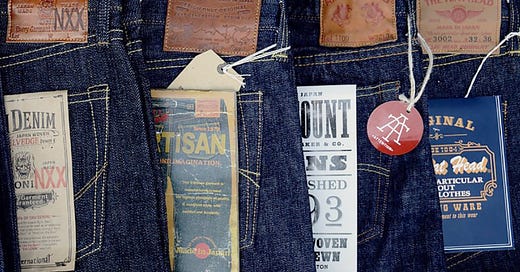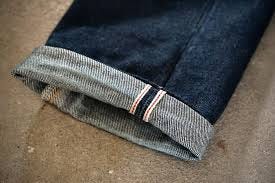Spring semester of my junior year, I was standing in line to get into Joe’s Brewery, a beloved campus establishment at which I frequent. While waiting, I noticed that the guy checking IDs at the door was wearing an interesting pair of jeans. I asked him about them when I got to the front of the line, while he was checking my ID, and it sparked a conversation a few minutes long between the two of us. His name is Christoff. I didn’t have to pay cover that evening, and I’d say Christoff was pleasantly surprised I noticed his pants.
These weren’t just any pants, they were a pair of selvedge denim jeans from a Japanese brand called ONI Denim. ONI is one of many brands in Japan that aim to perfect the practice of crafting selvedge denim jeans. Selvedge is a term that comes from the words “self-edge,” which means the jeans don’t unravel; the edges of the fabric won’t fray. Selvedge denim is also exclusively woven on a specific kind of loom called a shuttle loom. These factors make the fabric famously durable, but also notoriously heavy. Because of their extremely high quality and scarcity, these pants often have a price tag higher than your average Levi’s from the mall. (Even Levi’s has a premium “Made in Japan” line of selvedge denim available at select retailers.) I was able to tell that Christoff’s jeans were selvedge denim because of the distinct threading on the interior hem, a defining characteristic on all selvedge denim that’s only revealed when the wearer has the pants folded in a cuff at their ankle. It’s most commonly a red thread, but it can be any color.
Image via Denimhunters
Most selvedge denim is also raw denim, meaning the fabric hasn’t been washed or treated in any way before it’s turned into a garment. Denim is typically dyed blue with natural indigo, so raw denim is often a very deep shade of navy blue. Because it’s untreated and unwashed, the fabric develops interesting fading patterns that are completely unique to the wearer and reflect what they might do while wearing the pants. In order to develop these “fades,” wearers often go extremely long periods of time without washing their denim. Even hand-washing could alter the fades, as water removes even trace amounts of the indigo dye. To clean raw denim, it’s common to put them in a plastic bag and then into the freezer to kill any bacteria and keep them (somewhat) fresh. In addition to the high quality of the denim due to the weaving techniques, this fading process is often one of the most important aspects of owning these garments to those who make the investment. Selvedge denim enthusiasts take pride in their fades.
Most selvedge denim is made in Japan, which is why Japanese denim is a term almost synonymous with raw, selvedge denim. There’s a ton of lore as to the reason for this, but the abridged version is that most of the shuttle looms that exist in the world are in Japan. Shuttle looms are vintage looms from around WWII, and Japan just so happens to be the only country that has actively preserved the tradition of weaving on these looms while the rest of the world modernized after the war. There are other shuttle looms and selvedge denim manufacturers around the world, but most selvedge denim now comes from Japan.
Now, I don’t know much about the world of Japanese denim, I’ve never owned a pair myself, but I do know there’s a strong Japanese/selvedge denim culture among aficionados all over the world. There is an undeniable cult following for these garments. I was lucky enough to talk to Christoff again recently, and when I asked him if he considers himself to be a denim enthusiast, he told me he does: “[denim] has to be a top 3 fabric for clothing”
He was introduced to the world of selvedge denim through influencers on social media. He told me he actually “blew out” a pair of Levi’s while working at Joe’s, and he wanted to invest in something that would last. “i’m a fan of buying stuff for life,” he told me over text message. He says the investment has definitely paid off, estimating that after a year and a half with his ONI’s, he’s worn them about 400 times. In terms of engaging in selvedge denim culture, Christoff told me he uses social media to keep up with what his favorite brands in the space are releasing, as well as fellow enthusiast’s fade progress. I told you, those fades are no joke.
There’s enough of a demand that most major cities in the United States likely have a retailer that specializes in stocking Japanese brands that produce garments made out of selvedge denim. Christoff bought his ONI’s at a shop called Self Edge in Los Angeles, but there are similar stores specializing in Japanese denim as close as Chicago, such as Mildblend Supply and Independence.
Japanese denim has long been a closet staple for a subset of fashion enthusiasts and hipsters who have adopted workwear aesthetics, as well as folks who just want some damn good jeans. Now, the general public is beginning to take notice of the quality and character of these jeans, and their slow rise to relevance is manifesting itself in pop culture references such as singer Daniel Caesar’s 2015 hit, aptly named “Japanese Denim.” The song’s refrain is a testament to why everyone should at least consider investing in a pair of these pants: “My blue jeans will last me all my life.”
And if you don’t feel compelled to invest, even having a simple understanding of what this fabric truly is just might make you a new friend like Christoff.





fye 🔥🔥🔥